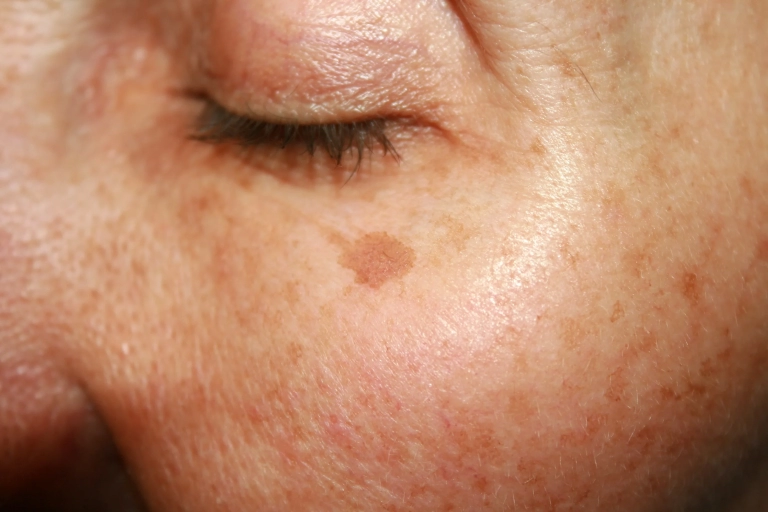Banish Dark Spots: Our Treatments For Flawless Skin
Have you noticed that you get dark spots on your skin as you age? This is a normal part of aging but can be bothersome. As we age, our skin cells sometimes produce too much pigment, resulting in dark spots.
Many people start noticing dark spots on their skin in their mid-40s to 50s. In most cases, these spots are benign and do not become cancerous. However, many want to see them gone, as they can become a cosmetic problem.
How do we get dark spots?
A scientific study of more than 500 people showed that the older we get, the more dark spots we tend to have. This means that it is a common sign of ageing. The study also found that the more sun-damaged the skin is, the higher the number of spots.
This indicates that sun damage and aging cause these spots. This also explains why they appear on sun-exposed areas of the skin, such as the dorsum of the hands, face, and arms.
Are dark spots similar to freckles?
No. Freckles are genetic and often run in the family. People with fair skin and/or red hair have significantly more freckles than those with darker skin. Sun exposure does not cause freckles, unlike dark spots, which mainly result from sunburns and excessive sun exposure.
Furthermore, we have freckles from birth or a very young age, whereas dark spots appear as we age.
The difference between different pigment areas of the skin
| Form of Pigmentation | Dark Spots | Freckles | Melasma |
|---|---|---|---|
| Cause | Ageing And Sun | Genetic, Fair skin and red hair | Hormones, female gender, sun |
| Treatments | IPL, Laser, Cryotherapy | IPL And Laser | Hydroquinone and chemical peels |
Our Dark Spot Treatment Options
Several treatment options are available for dark spots. This can be a bit confusing. So, let’s look at what works best. A new study looked at ways to treat dark spots and found that multiple treatments work best. So let’s compare them:
Prescription Cream
Most successful Dark Spot Treatment, easy and safe
A new study looked at ways to treat dark spots and found that multiple treatments work best. Surprisingly, they found that the best treatment is a simple prescription cream that contains 4-hydroxyanisole 2%/ tretinoin 0.01%.
In the study, people with dark spots used a cream and SPF 50+ sunscreen. Seventy-five per cent of dark spots disappeared completely. We particularly like this treatment because it is affordable, simple, and effective. We often combine it with Intense Pulsed Light for even better outcomes.
Laser with Cryotherapy
Effective with few adverse effects
Second on the list is a combination of laser treatments with cryotherapy or creams. The most effective laser is the PICO laser, which is superior at removing dark spots. The study shows that this can completely resolve 75% of dark spots.
However, this treatment is costly and may lead to pigmentation issues, especially for darker skin tones.
Laser Only
Best standalone treatment
Laser is the best treatment if used as a standalone treatment. Forty-three per cent of people will notice a complete resolution.
| Prescription Cream (4-hydroxyanisole 2%/ tretinoin 0.01%) And Sunscreen |
Laser Alone | IPL And Prescription Cream | Cryotherapy |
|---|---|---|---|
| 75 % Complete Fading | 43% Complete Resolution | 90% Fading of the spots | 15% Resolution |
| Mild Adverse Effects | 23% Adverse Effects | Very Few Adverse Effects | 33% Adverse Effects |
| Redness, irritation | Mainly Hyperpigmentation | Mild Redness | Blisters, Hyperpigmentation |
| Cheap and simple | Expensive | Several Sessions Needed | Not recommended |
Other available treatments for dark spots
Intense Pulsed Light
Intense pulsed light (IPL) therapy targets and breaks down melanin deposits in the skin. This treatment can be highly effective but requires multiple sessions. In between treatments, you must use extra skincare that targets pigmentation. It is also paramount to wear SPF 50+ sunscreen daily, even during the winter.
Microneedling
Microneedling involves using fine needles to create micro-injuries in the skin, stimulating collagen production and cell turnover. This can improve the appearance of sun spots and overall skin texture. At Satini Cosmetic Clinic, we inject high-quality ingredients gently into the skin to target pigment more effectively.
Chemical Peels
Chemical peels involve applying a solution to the skin that causes it to exfoliate and eventually peel off. This reveals new, less pigmented skin underneath. Peels can be superficial, medium, or deep, depending on the severity of the sun spots and skin type. For pigmentation issues, they are
Hydroquinone
Hydroquinone is a topical skin-lightening cream that inhibits melanin production. This cream works well for melasma but may not be as effective.
Cryotherapy
Cryotherapy treats dark spots by applying extreme cold to the skin using liquid nitrogen. This process freezes and destroys dark skin cells, helping the skin regenerate and reducing the appearance of dark spots.
In 2006, leading skin specialists from several countries came together to decide the best treatment for dark spots. At the time, they recommended cryotherapy as the number one treatment. But since then, more effective treatments such as IPL and laser have evolved.
Satini Cosmetic Clinic Results

IPL And Prescription Cream For Dark Spots
A woman in her 60s who was concerned about dark spots. After several IPL treatments and regular use of prescription cream, her skin appeared more even, radiant and lifted. The dark spots faded significantly and a few resolved completely.
Book Your Appointment
Satini Cosmetic Clinic provides treatments to target dark spots and help you achieve a more even and radiant complexion. Contact us today to schedule a consultation and start your journey to clearer, brighter skin.

